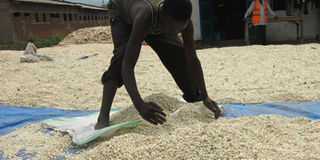900 farmers in Rwenzori region to profit from Shs800m grain deal

A farmer in Kasese dries maize on a tarpaulins. WFP has provide many tarpaulins to farmers as a measure of ensuring quality produce that the UN agency buys. PHOTO BY PAUL TAJUBA
What you need to know:
Limitation. 95 per cent of farmers produce on rented land meaning their expansion is limited
Kampala.
The World Food Programme (WPF), a United Nations agency and SNV, a Netherlands’ development organisation have contributed Shs800 million to boost grain production in the Rwenzori sub region.
Under the project, Purchase For Progress, the two organisations are targeting 900 farmers grouped in 31 clusters to increase quality and quantity maize and bean production to sustain local and WFP markets.
The money, according to Mr George William Oroma, the SNV agriculture advisor, will be channelled into skills development to help farmers produce more and set up satellite collection centres where harvests can be stored for use during dry seasons.
Purpose of funds
Additionally, the funds will also be used in finding markets and providing farmers with transport to ferry harvests to WFP warehouses (Nyakatonzi and Al-shadae) established in the region. Farmers will also get weighing machines, moisture meters and drying mats, among others, all aimed at minimising post-harvest losses and improving quality produce.
Mr Lazarous Byambale, the SNV project coordinator for Purchase For Progress told the Daily Monitor that currently, the Rwenzori region produces 1,314 tonnes of maize, 184 tonnes of rice and 471 tones for beans. He said the WFP and SNV initiative seeks to increase maize production to 1,529 tonnes, 573.3 beans and rice 294.3 tonnes.
The Resident District Commissioner for Kasese , Maj James Mwesigye, a prominent farmer in the region, advised farmers not to waste time involving themselves in tribal conflicts but instead engage in productive programmes.
challenges farmers face
Although majority of Ugandans depend on agriculture, farming is still faced with adverse effects of climate change like unreliable rainfall that affect productivity as well as manipulation by middlemen who buy farmers’ produce at low prices especially before harvests and because of poverty, the farmers give in.
Production is also affected by population increase that fragments potential farming land, poor quality farm inputs, storage systems and roads to reach markets.
In Rwenzori sub region, government has revamped Mubuku irrigation scheme to reduce the effects of drought that often hits the mountainous region especially the lee sides of the mountain.
Muhokya irrigation is also in use in Kasese.
Mr Lazarus Byambale, the SNV project coordinator for Purchase For Progress, said during the time, his organisation was profiling the farmers, they found out that 95 per cent were harvesting on rented land meaning their expansion is sometimes limited by ability to access land.
numbers
1,529
The number of tonnes of maize that the WFP and SNV initiative ia expected to produce, up from the current 1,314.
573.3
The number of tonnes of beans that WFP and SNV initiative is expected to produce, up from the current 471.
294.3
The number of tonnes of rice that WFP and SNV initiative is expected to produce, up from the current 184.



